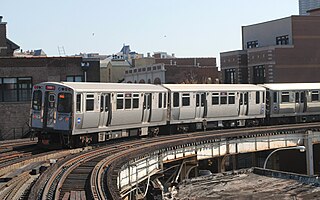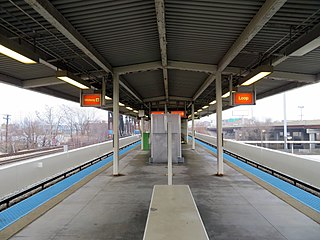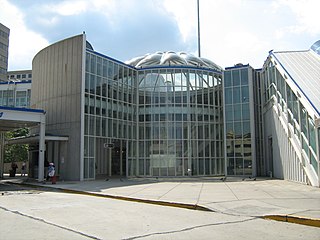
The Chicago "L" is the rapid transit system serving the city of Chicago and some of its surrounding suburbs in the U.S. state of Illinois. Operated by the Chicago Transit Authority (CTA), it is the fourth-largest rapid transit system in the United States in terms of total route length, at 102.8 miles (165.4 km) long as of 2014, and the third-busiest rapid transit system in the United States after the New York City Subway and the Washington Metro. As of January 2024, the "L" had 1,480 rail cars operating across eight different routes on 224.1 miles of track. CTA trains make about 1,888 trips each day servicing 146 train stations. In 2023, the system had 117,447,000 rides, or about 416,200 per weekday in the third quarter of 2024.

The Chicago Transit Authority (CTA) is the operator of mass transit in Chicago, Illinois, United States, and some of its suburbs, including the trains of the Chicago "L" and CTA bus service. In 2023, the system had a ridership of 279,146,200, or about 993,700 per weekday as of the third quarter of 2024.

The Red Line is a rapid transit line in Chicago, run by the Chicago Transit Authority (CTA) as part of the Chicago "L" system. It is the busiest line on the "L" system, with an average of 108,303 passengers boarding each weekday in 2023 The route is 26 miles (42 km) long with a total of 33 stations. It runs elevated from the Howard station in the Rogers Park neighborhood on the North Side, through the State Street subway on the Near North Side, Downtown, and the South Loop, and then through the Dan Ryan Expressway median to 95th/Dan Ryan in the Roseland neighborhood on the South Side.

The Orange Line is a rapid transit line in Chicago, Illinois, operated by the Chicago Transit Authority (CTA) as part of the Chicago "L" system. It is approximately 13 miles (21 km) long and runs on elevated and at grade tracks and serves the Southwest Side, running from the Loop to Midway International Airport. As of 2023, an average of 16,979 riders board Orange Line trains on weekdays.

The Blue Line is a 26.93-mile-long (43.34 km) Chicago "L" line which runs from O'Hare International Airport at the far northwest end of the city, through downtown via the Milwaukee–Dearborn subway and across the West Side to its southwest end in Forest Park, with a total of 33 stations. At about 27 miles, it is the longest line on the Chicago "L" system and second busiest, and one of the longest local subway/elevated lines in the world. It has an average of 72,475 passengers boarding each weekday in 2023.

The Brown Line of the Chicago "L" system, is an 11.4-mile (18.3 km) route with 27 stations between Chicago's Albany Park neighborhood and downtown Chicago. It runs completely above ground and is almost entirely grade-separated. It is the third-busiest 'L' route, with an average of 33,302 passengers boarding each weekday in 2023.

Howard is an 'L' station in Chicago, Illinois on the North Side Main Line. It is the northern terminus of the Red Line and the southeastern terminus of the Yellow Line; it also serves the Purple Line, for which it is the southern terminus at non-rush hour times on weekdays and all day on weekends. Trains on the Chicago North Shore and Milwaukee Railroad also stopped at Howard from 1926 until that line was abandoned in 1963.

The Pink Line is an 11.2 mi (18.0 km) rapid transit line in Chicago, run by the Chicago Transit Authority (CTA) as part of the Chicago "L" system. It is the CTA's newest rail line and began operation for a 180-day trial period on June 25, 2006, running between 54th/Cermak station in Cicero, Illinois and the Loop in downtown Chicago. As the line enters downtown Chicago, it begins to share tracks with Green Line trains on Lake Street. This connection is handled by the previously non-revenue Paulina Connector set of tracks. In 2023, over 3 million passengers boarded Pink Line trains.

Belmont is an 'L' station serving the CTA's North Side Main Line. It is served at all times by the Red and Brown Lines, and by the Purple Line Express during weekday rush hours. It is located at 945 West Belmont Avenue in the Lakeview neighborhood of Chicago, Illinois. It is an elevated station with two island platforms serving four tracks; Brown and Purple Line trains share the outer tracks while Red Line trains run on the inner tracks. Along with residential areas, the neighborhood surrounding Belmont contains many eclectic shops, bars, and restaurants and active nightlife. The station is one of the more heavily utilized on the system serving as a busy transfer point, and also as a terminal when the Brown Line operates as a shuttle service to and from Kimball late at night and early in the morning. It is nearly identical to Fullerton, minus the terminal status.

Pulaski is a station on the Chicago Transit Authority's 'L' system, serving the Green Line. Pulaski is located at the intersection of Lake Street and Pulaski Road in the West Garfield Park neighborhood of Chicago, Illinois. The station opened in March 1894.

O'Hare is a Chicago "L" station located at O'Hare International Airport, 17 miles (27 km) northwest of The Loop. The northwestern terminus of the Chicago Transit Authority's Blue Line, it is a subway station with two island platforms serving three tracks, situated under the parking garage for Terminals 1, 2, and 3. Trains are scheduled to depart from O'Hare every 2–7 minutes during rush-hour periods and take about 40 minutes to travel to the Loop. It is the westernmost station of the Chicago 'L' system. It is also the only station without coordinates in Chicago's grid system, the only underground terminus, and is the only terminal that does not directly connect to any CTA or Pace buses. Uniquely among "L" stations, it serves airport passengers and employees exclusively, and is not accessible by foot beyond airport terminals 1, 2, and 3. It is also one of three terminals that does not have a yard assigned to it.

Halsted station is an "L" station on the CTA Orange Line, located near the intersection of Halsted Street and Archer Avenue in the Bridgeport neighborhood of Chicago. The station opened in 1993 as part of the extension to Midway Airport. A previous railroad station just to the east opened in 1902 and served the Metra Heritage Corridor until 1984.

Ashland is a station on the Chicago Transit Authority's 'L' system, serving the Orange Line. It is located at the intersection of Ashland Avenue and 31st Street near the Stevenson Expressway. Although located within the Lower West Side community area, the station mostly serves the Bridgeport and McKinley Park neighborhoods.

35th/Archer is an 'L' station on the CTA's Orange Line, located in the McKinley Park neighborhood. The station has a Park 'n' Ride lot with 70 spaces.

Midway is an 'L' station on the CTA's Orange Line. It is the southwestern terminus of the Orange Line and serves Midway International Airport in Chicago, the city's second-largest airport. The turnstiles at the station's entrance are somewhat wider than most to accommodate airport passengers and their luggage. The station, along with the rest of the Orange Line, opened on October 31, 1993 after a long wait by Chicago's southwest side for 'L' access. It is also the closest station to SeatGeek Stadium, former home of the Chicago Fire, which is approximately 4 miles away. Although in the Garfield Ridge community area, the station serves many residents in the West Elsdon and West Lawn neighborhoods. Unlike O'Hare , passengers using Midway station do not pay an airport surcharge in addition to the standard "L" fare.

Cumberland is a station on the Chicago Transit Authority's 'L' system. Situated on the Blue Line between Rosemont and Harlem, the station is located in the median of the Kennedy Expressway at Cumberland Avenue in the O'Hare community area’s Schorsch Forest View neighborhood on Chicago's Northwest Side. It is also in close proximity to both the Norwood Park neighborhood and the city of Park Ridge as well as the village of Norridge. The area surrounding the station consists of mixed commercial and residential development.

Pulaski is a station on the Chicago 'L' system, serving the Blue Line's Forest Park branch. The station is located in the median of the Eisenhower Expressway and serves the West Garfield Park neighborhood. A long ramp connects the platform to the station house on the Pulaski Road overpass. There was originally a similar entrance from the Keeler Avenue overpass; the entrance from Keeler was closed to cut costs on January 15, 1973, but retained as an exit, and the exit was fully closed on December 28, 1978. The structure for this exit still stands but it is closed to the public.

Pulaski is an 'L' station on the CTA's Pink Line, located in the North Lawndale neighborhood. Pulaski opened on June 16, 1902, as part of the Douglas Park branch of the Metropolitan West Side Elevated Railroad. It served as the terminus of that line until its 1907 extension to 48th Avenue.

The Jefferson Park Transit Center is an intermodal passenger transport hub in the Jefferson Park neighborhood of Chicago, Illinois. It serves as a station for rail and also as a bus terminal. Jefferson Park Transit Center's railroad station is on Metra's Union Pacific Northwest Line, with the station located at 4963 North Milwaukee Avenue. Jefferson Park is 9.1 miles (14.6 km) away from Ogilvie Transportation Center in downtown Chicago, the inbound terminus of the Union Pacific Northwest Line. Under Metra's zone-based fare system, Jefferson Park is in zone 2. As of 2018, Jefferson Park is the 97th busiest of Metra's 236 non-downtown stations, with an average of 510 weekday boardings.

![]() and Kedzie stations. Pulaski is located at Pulaski Road and 51st Street on the Southwest Side of Chicago, Illinois. The station is within the Archer Heights neighborhood, which is both residential and commercial, and the station itself is in a commercial district on Pulaski Road. Pulaski opened on October 31, 1993, the opening date of the Orange Line.
and Kedzie stations. Pulaski is located at Pulaski Road and 51st Street on the Southwest Side of Chicago, Illinois. The station is within the Archer Heights neighborhood, which is both residential and commercial, and the station itself is in a commercial district on Pulaski Road. Pulaski opened on October 31, 1993, the opening date of the Orange Line.


















